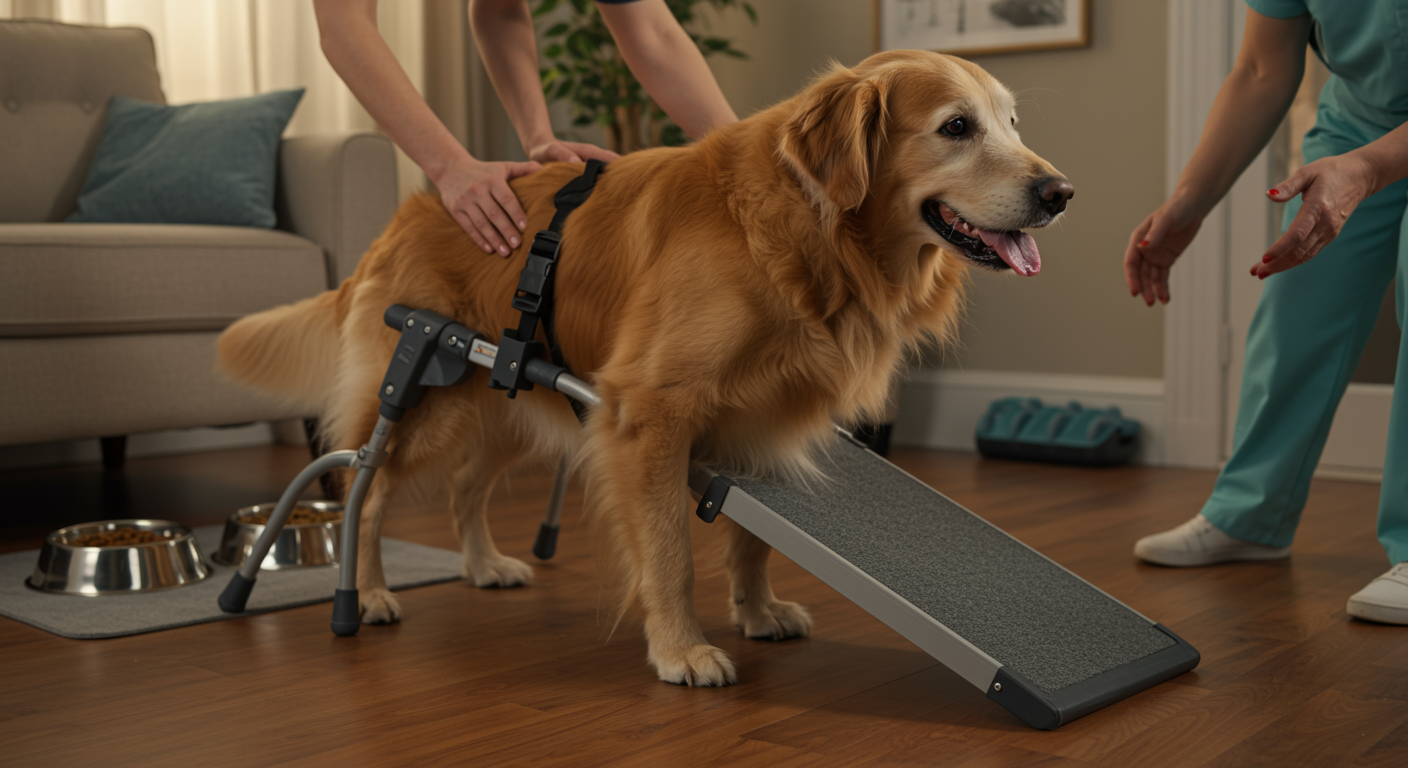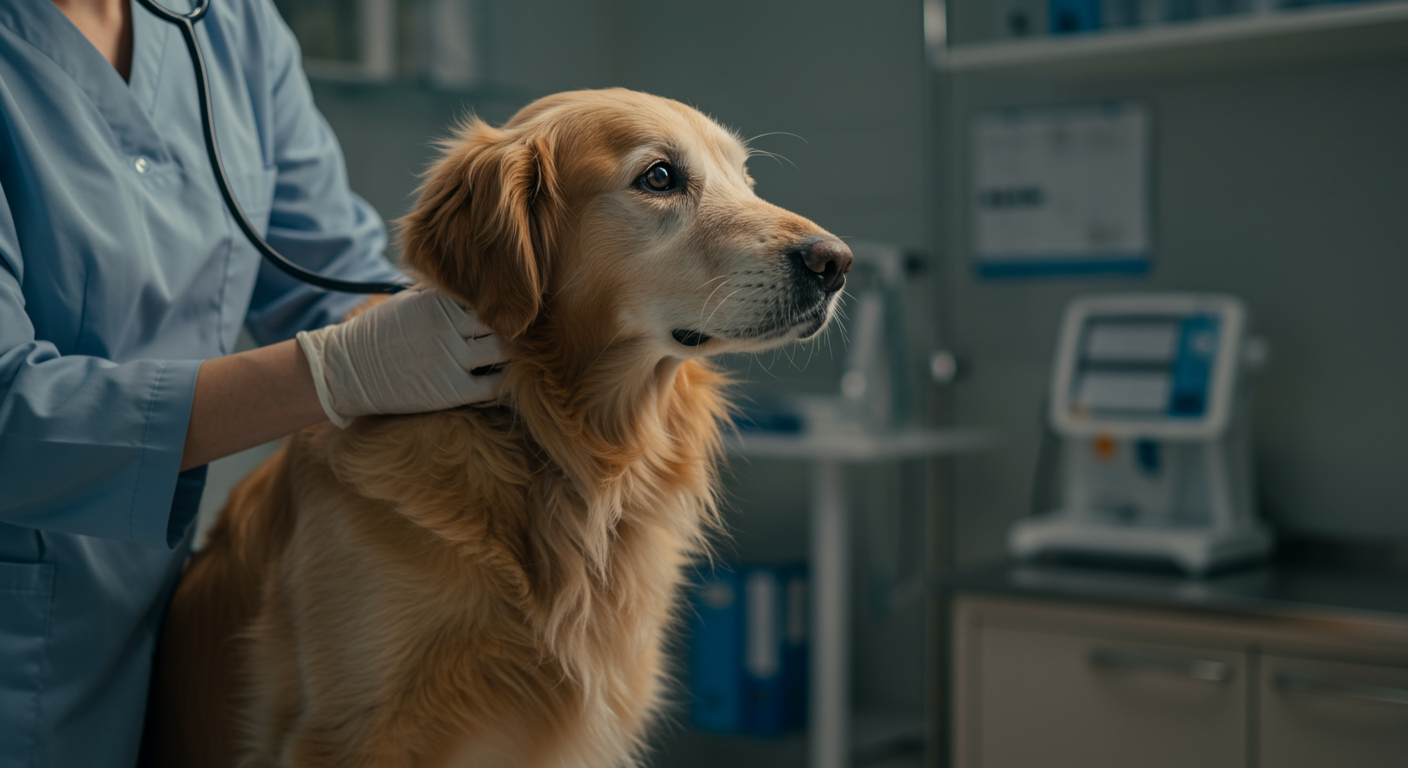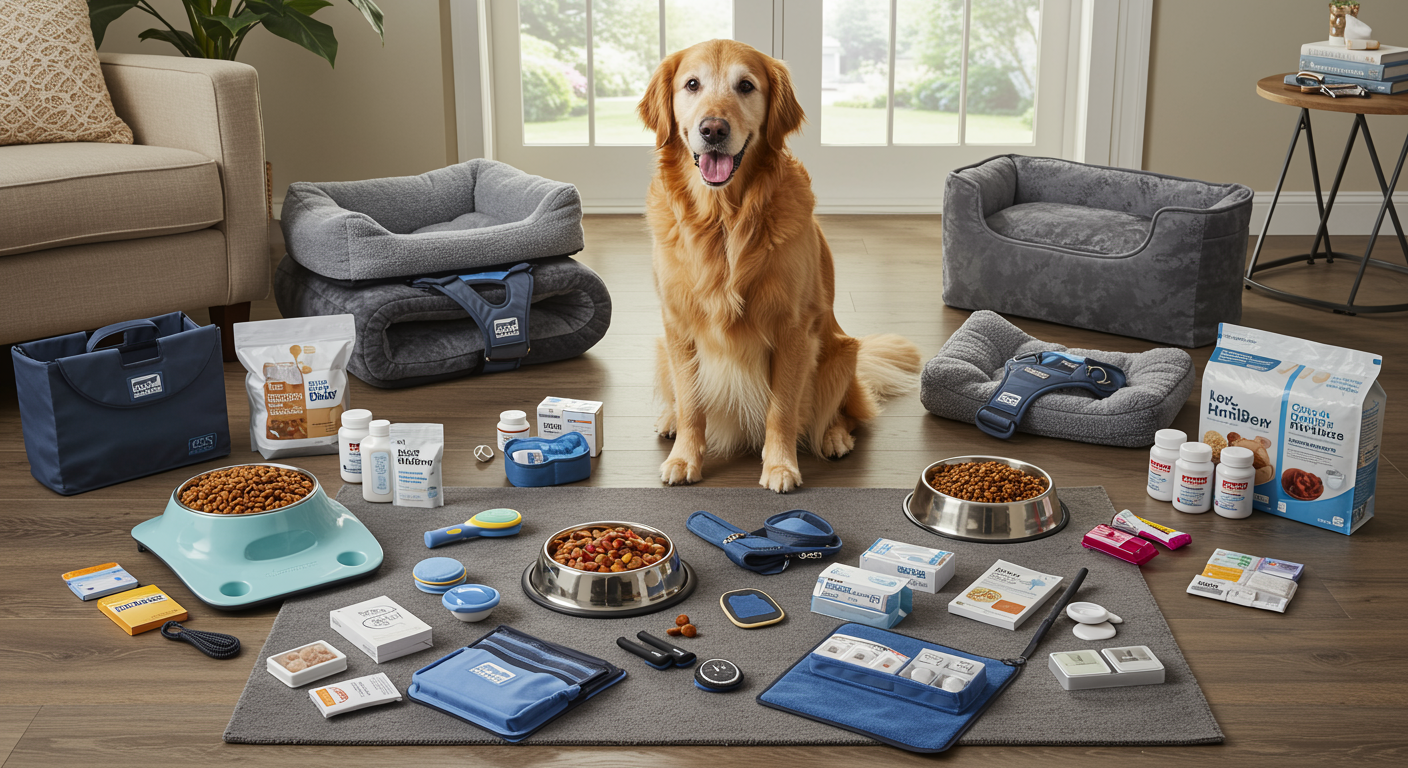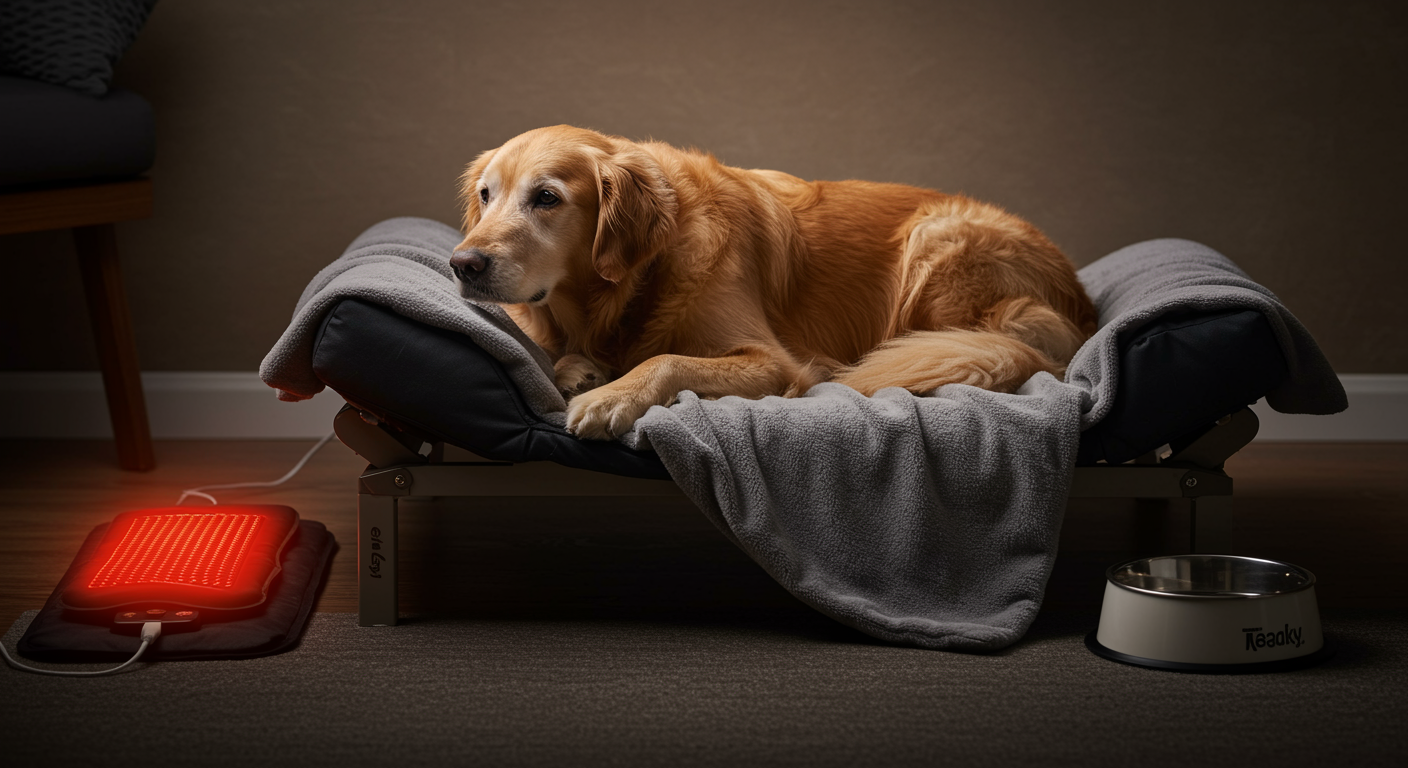Mobility challenges in senior Golden Retrievers can significantly impact their quality of life, independence, and overall well-being. Understanding practical solutions to address these issues helps families maintain their companions’ dignity while supporting their ability to navigate daily activities with comfort and confidence throughout their golden years.
Senior Golden Retrievers commonly experience mobility limitations due to arthritis, hip dysplasia, muscle weakness, or other age-related conditions that affect their movement capabilities. These challenges require thoughtful environmental modifications, supportive equipment, and lifestyle adaptations that preserve independence while ensuring safety.
Effective mobility support focuses on creating accessible environments, providing appropriate assistive devices, and implementing gentle exercise programs that maintain function while accommodating limitations. Success comes from understanding individual needs and implementing solutions that enhance rather than restrict daily activities.
Understanding Common Mobility Challenges
Age-Related Physical Changes
Joint Stiffness and Arthritis
Arthritis affects a majority of senior Golden Retrievers, causing joint inflammation, pain, and stiffness that particularly impact movement after periods of rest or during weather changes.
Understanding arthritis progression helps families recognize when mobility support becomes necessary while implementing interventions that slow progression and maintain comfort during daily activities.
Morning stiffness and reduced flexibility require patience and gentle encouragement as senior dogs work through initial movement difficulties before joints warm up and become more comfortable.
Muscle Weakness and Atrophy
Age-related muscle loss, particularly in the hindquarters, affects senior Golden Retrievers’ ability to rise from lying positions, climb stairs, or maintain balance during movement.
Understanding muscle changes helps families provide appropriate support while encouraging gentle exercise that maintains strength without overwhelming aging muscles and joints.
Weakness progression varies among individual dogs, making ongoing assessment important for adapting support strategies as capabilities change over time.
Balance and Coordination Issues
Proprioception Changes
Senior dogs may experience reduced proprioception (awareness of body position), leading to stumbling, difficulty navigating stairs, or uncertainty during movement on different surfaces.
Understanding proprioceptive changes helps families create safer environments while providing support that builds confidence during movement activities.
Balance challenges may be more pronounced on slippery surfaces or when navigating obstacles, requiring environmental modifications that support stable movement.
Vestibular System Effects
Inner ear changes or vestibular dysfunction can affect balance and spatial orientation, causing difficulty with head movements, turning, or maintaining steady gait patterns.
Understanding vestibular impacts helps families recognize when balance issues may indicate medical conditions requiring professional evaluation rather than simple aging changes.
Supportive strategies focus on creating predictable environments that reduce balance challenges while maintaining necessary movement for health and well-being.
Environmental Modifications for Enhanced Mobility
Home Accessibility Improvements
Flooring and Surface Modifications
Non-slip surfaces throughout the home help prevent falls while providing secure footing that builds confidence during movement activities and daily navigation.
Understanding surface safety helps families identify and modify slippery areas while maintaining attractive, functional flooring that supports both human and canine needs.
Area rugs, non-slip mats, or textured surfaces can provide traction on smooth floors while being removable for cleaning and maintenance.
Lighting and Visibility Enhancement
Adequate lighting helps senior dogs navigate safely, particularly those experiencing vision changes that make movement more challenging in dim conditions.
Understanding lighting needs helps families create well-lit pathways while avoiding harsh lighting that might be uncomfortable or create confusing shadows.
Night lighting provides safety during necessary nighttime movement while being gentle enough not to interfere with sleep or create anxiety.
Pathway and Access Solutions
Ramp Installation
Ramps provide gentle inclines that eliminate the need for jumping or climbing steps, making vehicles, porches, and elevated areas accessible for dogs with mobility limitations.
Understanding ramp specifications helps families select or build appropriate ramps with suitable gradients, width, and surface textures that provide safe, comfortable access.
Portable ramps offer flexibility for various locations while permanent installations provide consistent access to frequently used areas.
Mobility Support Solutions Guide
| Mobility Challenge | Practical Solution | Implementation | Benefits | Maintenance Requirements |
|---|---|---|---|---|
| Difficulty Rising | Orthopedic bedding, elevated surfaces | Strategic placement, gradual introduction | Reduced strain, improved comfort | Regular cleaning, replacement monitoring |
| Stair Navigation | Ramps, stair gates, assistance | Professional installation, training | Safety, maintained access | Periodic inspection, non-slip maintenance |
| Slippery Surfaces | Non-slip mats, booties | Strategic placement, gradual acclimation | Fall prevention, confidence | Regular washing, replacement |
| Vehicle Access | Car ramps, lifting aids | Proper sizing, patient introduction | Maintained mobility, reduced lifting | Storage, cleaning, wear monitoring |
| Balance Issues | Support harnesses, stable surfaces | Professional fitting, practice | Confidence, safety | Adjustment, cleaning |
| Outdoor Navigation | Pathway lighting, clear routes | Installation, routine establishment | Safety, independence | Bulb replacement, pathway clearing |
Assistive Equipment and Devices
Support Harnesses and Slings
Mobility Harnesses
Well-fitted mobility harnesses provide support during walking while offering handles that allow family members to assist with balance or provide gentle lifting support when needed.
Understanding harness selection helps families choose appropriate designs that distribute weight properly while being comfortable for extended wear during daily activities.
Proper fitting ensures effectiveness while preventing chafing or discomfort that could make dogs reluctant to wear supportive equipment.
Lifting and Support Slings
Support slings help assist dogs with rear-end weakness while allowing them to maintain dignity and some independence during movement activities.
Understanding sling usage helps families provide appropriate support while encouraging continued movement and exercise that maintains remaining strength and function.
Training for both dogs and family members ensures safe, effective use of support equipment while building confidence in assistive device utilization.
Mobility Aids and Equipment
Orthopedic Bedding
Supportive bedding helps reduce pressure on joints while providing comfortable rest areas that make rising easier after sleep or rest periods.
Understanding bedding benefits helps families select appropriate materials and designs that provide joint support while maintaining comfort and temperature regulation.
Strategic placement of orthopedic bedding throughout the home ensures that comfortable rest options are available wherever dogs spend time.
Raised Food and Water Bowls
Elevated feeding stations reduce neck and back strain during eating and drinking while making these essential activities more comfortable for dogs with mobility limitations.
Understanding elevation benefits helps families select appropriate heights while ensuring that bowls remain stable and accessible during use.
Adjustable height options allow for modifications as mobility needs change over time, ensuring continued comfort and accessibility.
Exercise and Physical Therapy
Gentle Exercise Programs
Low-Impact Activities
Swimming, slow walking, and controlled movement exercises help maintain muscle strength and joint mobility while respecting physical limitations and comfort levels.
Understanding appropriate exercise helps families develop routines that provide health benefits while avoiding overexertion or activities that might worsen mobility issues.
Consistency in gentle exercise helps maintain function while preventing the muscle weakness that can result from inactivity due to mobility concerns.
Range of Motion Activities
Gentle stretching and passive range of motion exercises help maintain joint flexibility while providing bonding opportunities through therapeutic touch and care.
Understanding movement therapy helps families learn appropriate techniques while recognizing the difference between beneficial stretching and potentially harmful manipulation.
Professional guidance ensures that therapeutic activities remain safe and beneficial while complementing other mobility support strategies.
Physical Therapy Integration
Professional Rehabilitation Services
Certified canine rehabilitation therapists provide specialized assessment and treatment programs that address individual mobility challenges through targeted interventions.
Understanding professional services helps families access appropriate care while learning home techniques that support ongoing mobility maintenance and improvement.
Regular professional assessment helps track progress while adjusting therapy approaches based on changing needs and capabilities.
Home Therapy Programs
Simple exercises and activities that can be performed at home help maintain therapeutic benefits while making mobility support a regular part of daily routines.
Understanding home therapy helps families implement consistent support while building skills and confidence in providing ongoing mobility assistance.
Integration with daily activities makes therapy feel natural while ensuring that mobility support becomes part of regular care rather than additional burden.
Daily Living Adaptations
Routine Modifications
Activity Pacing
Breaking daily activities into smaller segments with rest periods helps senior dogs manage mobility challenges while maintaining participation in enjoyable activities.
Understanding pacing benefits helps families adapt expectations while ensuring that dogs continue to experience variety and stimulation within their capabilities.
Flexible scheduling allows for good and difficult days while maintaining overall activity levels that support physical and mental well-being.
Assistance Strategies
Learning when and how to provide assistance helps families support mobility while preserving independence and dignity throughout daily activities.
Understanding assistance timing helps balance support with encouragement of independent movement that maintains strength and confidence.
Consistent assistance approaches help dogs understand expectations while building trust in family members’ ability to provide safe, comfortable support.
Comfort and Pain Management
Environmental Comfort
Temperature control, comfortable surfaces, and draft elimination help reduce stiffness and discomfort that can worsen mobility challenges.
Understanding comfort factors helps families create environments that support movement while providing relief from conditions that might increase mobility difficulties.
Seasonal adjustments help maintain comfort during weather changes that commonly affect arthritis and joint stiffness in senior dogs.
Professional Pain Management
Working with veterinarians to develop comprehensive pain management plans helps ensure that mobility issues don’t compromise quality of life or prevent necessary movement.
Understanding pain management options helps families make informed decisions about medications, supplements, and alternative therapies that support mobility.
Regular pain assessment helps ensure that management strategies remain effective while adapting to changing needs and conditions.
Safety Considerations
Fall Prevention
Hazard Identification
Removing obstacles, securing loose rugs, and eliminating hazards helps prevent falls while creating safer environments for dogs with balance or coordination challenges.
Understanding safety assessment helps families identify potential problems while maintaining attractive, functional living spaces that accommodate mobility needs.
Regular safety reviews help ensure that environments remain appropriate as mobility challenges evolve or change over time.
Emergency Preparedness
Having plans for mobility emergencies helps families respond appropriately when dogs experience sudden mobility loss or injury requiring immediate support.
Understanding emergency responses helps families prepare for situations where normal mobility support may be insufficient or when professional care becomes necessary.
Communication with veterinary professionals about emergency protocols ensures appropriate responses while maintaining access to necessary care and support.
Equipment Safety
Proper Usage Training
Learning correct techniques for using mobility equipment helps ensure safety while maximizing the benefits of assistive devices and support tools.
Understanding equipment limitations helps families use devices appropriately while recognizing when professional guidance may be necessary for safe implementation.
Regular equipment inspection helps maintain safety while ensuring that assistive devices continue to provide appropriate support without creating additional hazards.
Quality of Life Maintenance
Independence Preservation
Encouraging Self-Reliance
Supporting dogs’ efforts to maintain independence helps preserve dignity while building confidence in their ability to navigate mobility challenges successfully.
Understanding independence balance helps families provide necessary support while encouraging continued effort and participation in daily activities.
Celebrating small achievements helps maintain motivation while building positive associations with movement and mobility support activities.
Adaptive Strategies
Modifying activities to accommodate changing capabilities helps maintain participation in enjoyable experiences while respecting physical limitations.
Understanding adaptation helps families find creative solutions that preserve favorite activities while ensuring safety and comfort during participation.
Flexible approaches help maintain quality of life while adapting to evolving needs and changing capabilities throughout the aging process.
Emotional Support
Confidence Building
Providing patient support and encouragement helps build confidence in dogs who may feel uncertain about their changing capabilities and mobility limitations.
Understanding emotional needs helps families provide appropriate reassurance while maintaining positive attitudes that support continued effort and participation.
Positive reinforcement for movement efforts helps maintain motivation while building trust in family support during challenging mobility situations.
Stress Reduction
Minimizing stress around mobility activities helps ensure that necessary movement remains positive rather than becoming a source of anxiety or fear.
Understanding stress factors helps families create supportive environments while maintaining calm, encouraging approaches to mobility challenges.
Patience and understanding help reduce frustration while building positive associations with mobility support and assistive activities.
Long-Term Planning
Progressive Support
Anticipating Changing Needs
Planning for evolving mobility needs helps families prepare appropriate support while ensuring that solutions remain effective as conditions progress.
Understanding progression patterns helps families invest in adaptable solutions while avoiding equipment or modifications that may quickly become inadequate.
Proactive planning helps ensure continued quality of life while maintaining access to appropriate support throughout changing mobility needs.
Resource Development
Building relationships with professionals and suppliers helps ensure access to appropriate support and equipment as mobility needs evolve over time.
Understanding resource networks helps families access expertise while maintaining connections that support ongoing mobility management and problem-solving.
Community connections can provide valuable support and information while offering opportunities to learn from other families facing similar mobility challenges.
Success Measurement
Quality of Life Assessment
Regular evaluation of mobility support effectiveness helps ensure that interventions enhance rather than complicate daily life and overall well-being.
Understanding success indicators helps families recognize when mobility support strategies are working effectively while identifying when adjustments may be needed to maintain optimal outcomes.
Objective measures such as activity levels, participation in favorite activities, and overall comfort help assess the effectiveness of mobility interventions while guiding ongoing support decisions.
Cost-Effective Solutions
Budget-Friendly Options
DIY Modifications
Simple home modifications using readily available materials can provide effective mobility support while managing costs for families with budget constraints.
Understanding DIY options helps families create effective solutions using materials like non-slip mats, ramps made from plywood, or elevated feeding stations constructed from household items.
Safety considerations remain paramount when implementing homemade solutions, ensuring that cost savings don’t compromise effectiveness or create additional hazards.
Gradual Implementation
Prioritizing mobility solutions based on immediate needs helps families manage costs while ensuring that essential support is provided first before addressing less critical issues.
Understanding implementation priorities helps families focus resources on solutions that provide the greatest benefit while planning for additional improvements over time.
Phased approaches allow families to spread costs while building experience with mobility support before investing in more complex or expensive solutions.
Long-Term Investment Planning
Durable Equipment Selection
Choosing quality equipment that provides long-term value helps ensure that mobility investments continue to provide benefits while minimizing replacement costs over time.
Understanding equipment durability helps families balance initial costs with long-term effectiveness while selecting items that will provide reliable support throughout the senior years.
Professional-grade equipment often provides better value over time despite higher initial costs, making investment decisions important for long-term mobility support success.
Addressing mobility issues in senior Golden Retrievers requires comprehensive approaches that combine environmental modifications, assistive equipment, and supportive care strategies. Through understanding individual needs and implementing appropriate solutions, families can help their senior companions maintain dignity, independence, and quality of life despite mobility challenges.
Success in mobility support comes from recognizing that small adaptations can make significant differences in daily comfort and function. With patience, creativity, and appropriate resources, most mobility challenges can be effectively managed while preserving the joy and companionship that define the human-dog relationship.
The investment in mobility solutions demonstrates commitment to comprehensive senior dog care while ensuring that physical limitations don’t prevent continued participation in family life and enjoyable activities throughout the golden years.

Rafael Souza is a digital marketing strategist and lifelong dog enthusiast. Passionate about Golden Retrievers, he shares practical, research-based tips to help owners provide healthier and happier lives for their furry companions.






1 thought on “Mobility Issues in Senior Golden Retrievers: Practical Solutions”